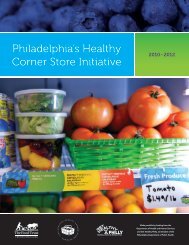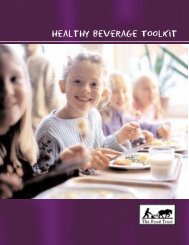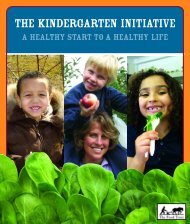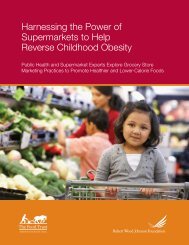The Grocery Gap: Who Has Access to Healthy - The Food Trust
The Grocery Gap: Who Has Access to Healthy - The Food Trust
The Grocery Gap: Who Has Access to Healthy - The Food Trust
You also want an ePaper? Increase the reach of your titles
YUMPU automatically turns print PDFs into web optimized ePapers that Google loves.
PolicyLink<strong>The</strong> <strong>Food</strong> <strong>Trust</strong>Availability of <strong>Food</strong> S<strong>to</strong>res in Rural Areas by S<strong>to</strong>re Type, 2000analysis found that there are 418rural “food desert” counties where allresidents live 10 miles or more from thenearest supermarket or supercenter—20percent of all rural counties. 43• In the Mississippi Delta, over 70 percen<strong>to</strong>f households eligible <strong>to</strong> receivefood stamp benefits needed <strong>to</strong> travelmore than 30 miles <strong>to</strong> reach a largegrocery s<strong>to</strong>re or supermarket. 36• In New Mexico, rural residents haveaccess <strong>to</strong> fewer grocery s<strong>to</strong>res than urbanresidents, pay more for comparable items,and have less selection. <strong>The</strong> same marketbasket of groceries costs $85 for ruralresidents and $55 for urban residents. 113Transportation access2.Lack of transportation <strong>to</strong> supermarkets is a majorbarrier for residents in many communities. 115Assessments of Lexing<strong>to</strong>n (KY), Seattle (WA), Centraland South Los Angeles (CA), East Austin (TX), andTrinity County (CA) highlighted transportationchallenges. 11, 12, 22, 69, 116 Rural residents have highervehicle ownership generally, but those who lackreliable access <strong>to</strong> personal vehicles are particularlyisolated given the longer distances <strong>to</strong> s<strong>to</strong>res and12, 51, 114, 116, 117lack of public transportation options.Better access <strong>to</strong> healthy foodcorresponds with healthier eatingConsistent with the conclusions of a recent reviewstudy, 4 we found strong and consistent evidenceindicating a positive relationship between access<strong>to</strong> healthy food and eating behaviors. Withoutnearby access <strong>to</strong> healthy ingredients, familieshave a harder time meeting recommended dietaryguidelines for good health such as eating fruitsand vegetables and lowering fat intake. In asurvey of diabetic adults in New York’s East Harlemneighborhood, 40 percent said that they didnot follow the recommended dietary guidelinesbecause the necessary foods were less available andmore expensive in their neighborhood s<strong>to</strong>res. 31Of 14 studies that examine food access andconsumption of healthy foods, all but one of themfound a correlation between greater access andbetter eating behaviors. All of the studies in thiscategory were conducted by academic researchersand published in peer-reviewed journals. 118<strong>Access</strong> <strong>to</strong> supermarketsEight studies analyzed access <strong>to</strong> nearby supermarketsor large grocery s<strong>to</strong>res that sell a widevariety of healthy foods in relation <strong>to</strong> consumptionof fruits and vegetables, specific healthy foods (suchas low-fat milk or high-fiber bread), or a healthy diet(measured by an index of diet quality). Almost all16






